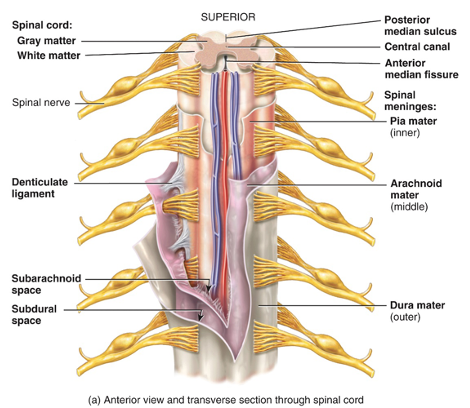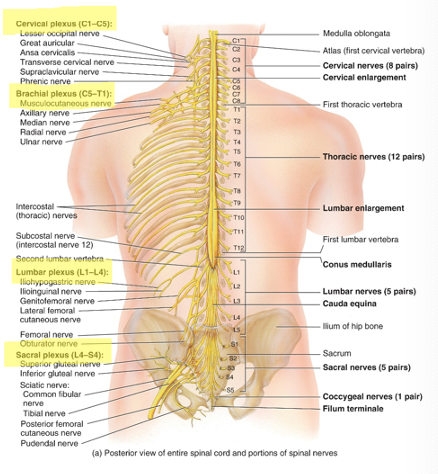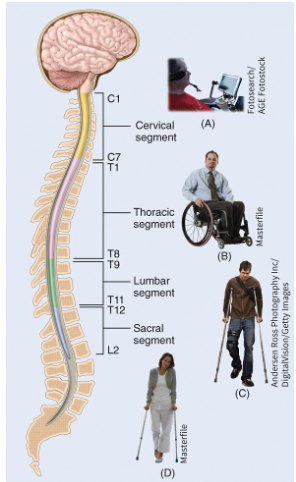ch 10, 12, 13, HW, Case Studies
1/244
There's no tags or description
Looks like no tags are added yet.
Name | Mastery | Learn | Test | Matching | Spaced |
|---|
No study sessions yet.
245 Terms
what are the spinal cord functions?
process reflex, integrate EPSPs and IPSPs, conduct sensory impulses to the brain, and motor impulses to effectors.
what is the spinal cord protected by?
bone (vertebrae), connective tissue (meninges), and cerebrospinal fluid
what are the 3 layers of the meninges?
dura mater, arachnoid mater, pia mater

The spinal cord begins as an extension of the _________ at the level of the _________ and terminates at ___________.
medulla oblongata; foramen magnum; the level of L2.

where does incoming sensory info enter?
through the posterior cord.
how is incoming sensory info transmitted to the brain?
through ascending fibers and then the brain integrates/interprets the info
how does outgoing “motor” info descend?
through the anterior cord.
what do spinal nerves connect?
CNS to sensory receptors, muscles, and glands.
what system are spinal nerves a part of?
peripheral nervous system.
how many pairs of spinal nerves?
31, mostly corresponding to the levels of vertebra
what is a spinal nerve attached to and how?
a segment of the spinal cord by anterior and posterior roots
what do spinal nerves enter/exit through?
intervertebral foramen.
what are dermatomes?
segments of skin containing spinal nerves.
what do dermatomes do?
carry somatic sensory nerve impulses to the brain.
what is the cervical plexus?
network of nerves in the skin and muscles of the head, neck, diaphragm, superior portion of the shoulders, and chest.
what is the brachial plexus?
nerve supply to the shoulders and upper limbs
what is the lumbar plexus?
nerve supply of skin and musculature of lower limbs
what is the sacral plexus?
motor and sensory nerve supply for the posterior thigh, most of the lower leg, the entire foot, and part of the pelvis.
how does the spinal cord contribute to homeostasis?
by propagating nerve impulses and integrating information
how does information travel in the spinal cord?
white matter tracts conduct nerve impulses to and from the brain, while gray matter receives and integrates incoming and outgoing information to perform spinal reflexes.
what is a reflex?
a fast, involuntary, unplanned response to a particular stimulus
what is ipsilateral?
same side
what is contralateral?
opposite side
what is monosynaptic?
one
what is polysynaptic?
more than one
what is reciprocal innervation?
neural circuit simultaneously contracts one muscle and relaxes its antagonists
what does a stretch reflex do?
causes the contraction of a muscle that has been stretched.
what does a tendon reflex do?
causes the relaxation of the muscle attached to the stimulated tendon.
what does a flexor (withdrawal) reflex do?
causes withdrawal of a limb to avoid injury or pain.
what does a crossed-extensor reflex do?
maintains balance during a withdrawal reflex.
what are the traumatic injuries?
monoplegia, paraplegia, hemiplegia, quadriplegia.
what does the damage that results from traumatic injuries depend on?
the degree of spinal cord section or degree of compression of the segments involved.
what does the extent of paralysis from traumatic injury depend on
location of the injury:
A – no function from the neck down
B – some arm and chest muscle control
C – most thigh muscles
D – most leg muscles

what are shingles
Acute infection of the PNS caused by herpes zoster virus (also causes chickenpox). causes pain, discoloration of the skin, and line of skin blisters.
what are some disorders?
spinal cord compression, degenerative diseases (multiple sclerosis, amyotrophic lateral sclerosis), and poliomyelitis (polio).
somatic and special senses (esp. _______) = sensory input to CNS
cranial nerves
functions of nervous system?
sensory input, integrative (brain), motor output (effectors)
which function:
detects changes through sensory receptors
sensory input
digestive system can _____ independently of nervous system input
"act"
CNS to motor output = somatic nervous system (_____(1)_____) and autonomic nervous system (_____(2)____)
(1) voluntary
(2) involuntary
which function:
analyze incoming sensory info, store some aspects, make decisions regarding appropriate behaviors
integrative (brain)
which function:
respond to stimuli via effectors
motor output
examples of motor output (effectors)?
muscles and glands
nerve impulse is called an?
action potential
action potential:
due to movement of?
ions across cell membranes
action potential: due to movement of ions across cell membrane; esp. what ions?
sodium and potassium
receives communication from adjacent neurons =
dendrite
"supports" neurons =
neurological cell
DNA, protein synthesis, etc. =
cell body
transmits action potentail =
axon
allows for integration of a great deal of info from other neurons
multipolar neuron
multipolar neuron:
possesses a single ___(1)___ and many ___(2)___
(1) axon
(2) dendrites
has 2 distinct structures extending from the cell body - an axon and dendrite - uncommon - esp. special senses
bipolar neurone
only occurs as a general sensory neuron
pseudo-unipolar neuron
neurons can be classified based on?
the direction of nerve impulse propagation
conveys info to the CNS =
sensory/afferent neurons
conveys action potential to the CNS =
motor/efferent neurons
process sensory info and elicit motor response =
interneurons/association neurons
interneuron =
usually multipolar axon
"nerve glue", provides lattice-work, maintains proper ionic environment, etc. =
neuroglia
are neuroglia electrically excitable?
NO
neuroglia make up about ________ the volume of the nervous system.
half
what can neuroglia do?
multiply and divide
can neurons multiply?
NO
there are 6 kinds of neuroglia, specifically:
4 in CNS, 2 in PNS
the myelin sheath is produced by ___(1)___ (PNS) and ___(2)___ (CNS) and it surrounds the axons of most neurons.
(1) Schwann cells
(2) oligodendrocytes
allow communication over short and long distances
action potentials (AP)
allow communication over short distances only
graded potentials (GP)
production of an AP or a GP depends on the existence of?
resting membrane potential and certain ion channels
in the brain:
the _________ directs the sensory info to the appropriate lobe
thalamus
the ________ interprets info and sends a response
brain
sensory impulses ascend up the ___(1)___ to the ___(2)___
(1) spinal cord
(2) brain
motor impulses descent down the spinal cord to an ________, which responds
effector
- ___(1)___ channels respond to chemical stimuli
- ___(2)___ binds to the receptor
- a.k.a. chemically gated
- i.e. ___(3)___
(1) ligand-gated
(2) ligand
(3) a drug
- ___(1)___ channels responde to mechanical vibration or pressure stimuli
- i.e. ___(2)___
(1) mechanically-gated
(2) in skin
___(1)___ channels respond to direct changes in membrane potential
voltage-gated
gated channels that open in response to binding of ligand (chemical) stimulus
ligand-gated channels
gated channels that open in response to mechanical stimulus (like touch, pressure, vibration, tissue stretching)
mechanically gated channels
gated channels that open in response to voltage stimulus (change in membrane potential)
voltage-gated channels
the membrane of a non-conducting [resting] neuron is relatively positive outside and negative inside; this is determined by...?
- unequal distribution of ions across the plasma membrane and selective permeability of the neuron's membrane to Na and K
- most anions cant leave the cell
- Na/K ATPase pumps 3Na+ out in exchange for 2K+ in
stimulus strength =
amplitude of graded potentials depends on the stimulus strength
graded potentials: stimulus strength
Remember: an action potential is not generated until __________ is reached [usually ~55mV]
"threshold potential"
summation =
graded potentials can be added to become larger in amplitude
action potentials have 2 phases:
depolarization, repolarization
depolarization =
becoming more positive inside
repolarization =
returning to more negative inside, requires energy Na/K ATPase
action potentials can only occur if the membrane potentials reaches...?
threshold
action potentials are "all or none" - i.e. ___________
either a neuron "fires" or it does not
Action Potentials: the Status of Na+ and K+ Voltage-Gated Channels
when:
- all voltage-gated Na+ and K+ channels are closed
resting state
Action Potentials: the Status of Na+ and K+ Voltage-Gated Channels
when:
- membrane potential of axon reaches threshold - the Na+ channel activation gates open
- Na+ rushes in
depolarizing phase
Action Potentials: the Status of Na+ and K+ Voltage-Gated Channels
when:
- Na channels inactivation gates close and K channels open
- K+ leaves neuron
- inside becoming negative again
repolarizing phase begins
Action Potentials: the Status of Na+ and K+ Voltage-Gated Channels
when:
- K+ outflow continues
- as more K ions leave the neuron, more negative changes build up along inside surface of membrane
- K+ continues leaving neuron
- inside becoming negative again
repolarization phase continues
in order for communication to occur from one body to another, action potentials must travel from where they arise at the trigger zone to the axon terminals - this traveling is called?
propagation
action potentials do not die out; they keep their strength as they spread across the membrane of a neuron - remember:
all or nothing principle
factors that affect propagation speed:
- axon diameter
- amount of myelination
- temp
amount of myelination =
myelin increases speed of AP propagation
junction between neurons or between neuron and an effector
synapse
gap junctions connect cells and allow the transfer of info to synchronize the activity of a group of cells
electrical synapse
electrical synapse:
ensures that all cells fire ____(1)____ at about the same time - ions flow directly between cells - i.e. ____(2)____
(1) action potentials
(2) between cardiac muscle cells
one way transfer of info from a presynaptic neuron to a postsynaptic neuron
chemical synapse